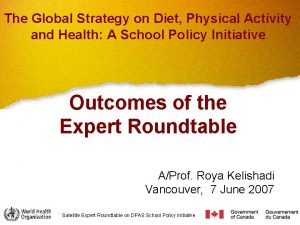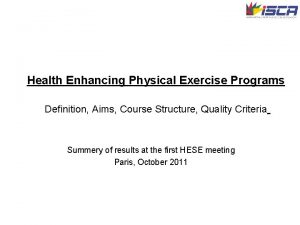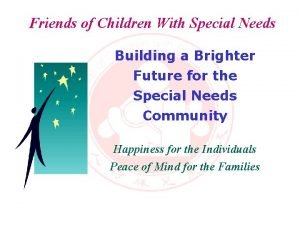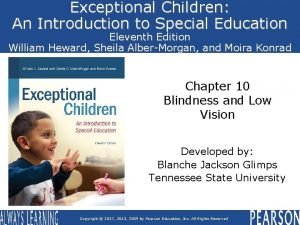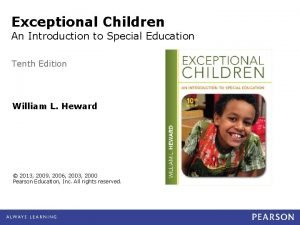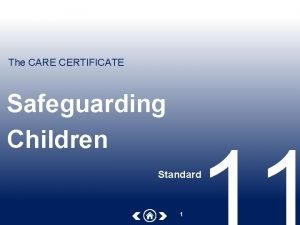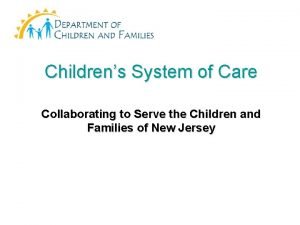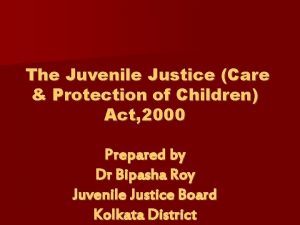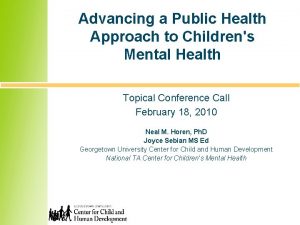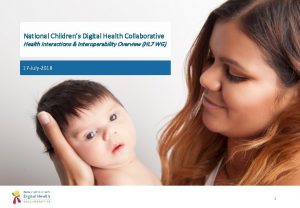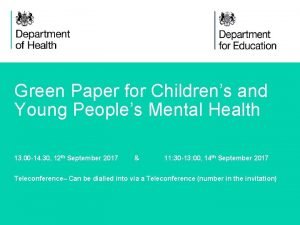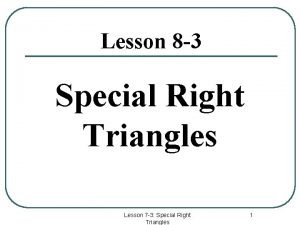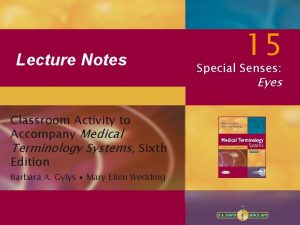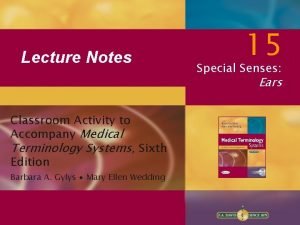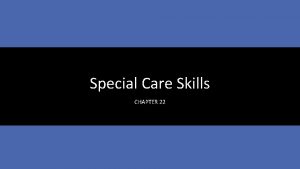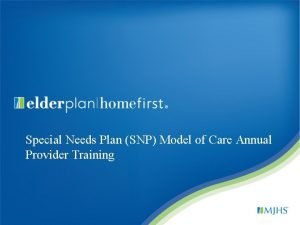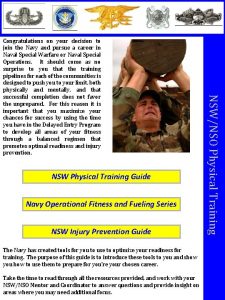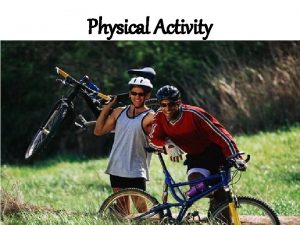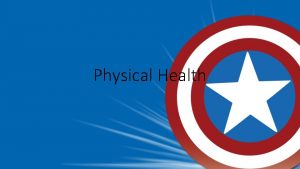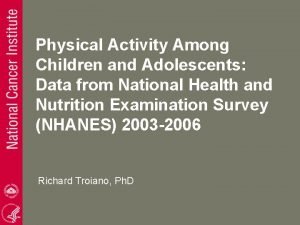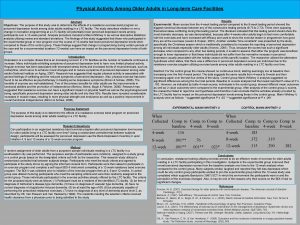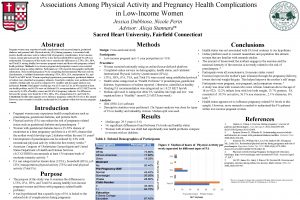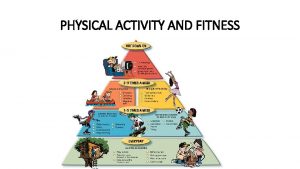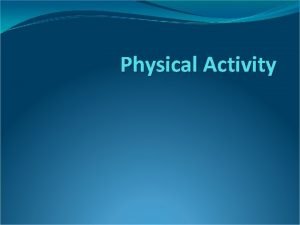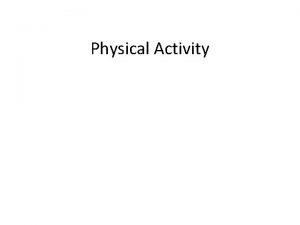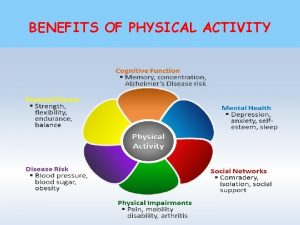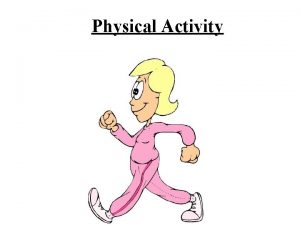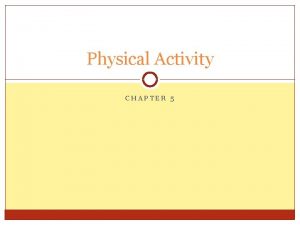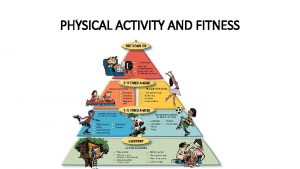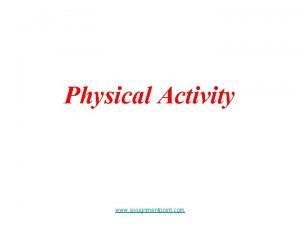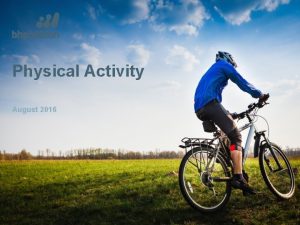Physical Activity Among Children with Special Health Care













![Independent Variables Condition Severity “Does [CHILD’S NAME] currently have condition? ” “Would you describe Independent Variables Condition Severity “Does [CHILD’S NAME] currently have condition? ” “Would you describe](https://slidetodoc.com/presentation_image_h2/7310308f05c56a902f1b89f8f2e16440/image-14.jpg)









- Slides: 23

Physical Activity Among Children with Special Health Care Needs FINDINGS FROM THE NATIONAL SURVEY OF CHILDREN’S HEALTH Amelia Phillips, BS, CPH (Provisional) | MCH Leadership Training Program Scholar University of South Florida 2015 Making Lifelong Connections Meeting 4/24/2015

Outline • Public Health Significance o Physical inactivity among children with special health care needs (CSHCN) • Methods • Results • Discussion

Public Health Significance • Essential component of a healthy lifestyle • Important for healthy growth and development • May result in benefits across the life span 3

Physical Inactivity • Physical inactivity major risk factor for chronic disease and disability • Higher prevalence of obesity among CSHCN • 20% of CSHCN vs. 15% non-CSHCN • Greatest risk among children with mobility limitations and intellectual disabilities 4

Life Course Implications of Physical Inactivity • Limited involvement during school increases risk for sedentary lifestyles after graduation • ASD, Intellectual disabilities and multiples disabilities most likely to spend leisure time watching TV. • Early exposure is crucial 5

Systems Barriers among CSHCN • • Perceptions, attitudes and beliefs held by parents Poor communication between parents and teachers Attitudes of program leaders and participants Lack of opportunities o Limited physical accessibility • Lack of transportation • Limited awareness of how to adapt services/ activities 6

Inclusive Opportunities • Recent movements toward inclusion in recreation activities have changed programmatic focus o ADA discrimination laws ensure access • Need to ensure supports and resources are available to equip CSHCN with the necessary skills 7

Importance of Parent Involvement • Parental involvement positively associated with child’s education achievement levels o o o Special education, gifted All types of involvement All ages of children • Despite shift towards inclusion in all areas of the community, effect of parental involvement on physical activity remains unknown 8

Study Purpose • To investigate physical activity levels among children ages 6 -17 by severity level of special health care need • To explore relationship between physical activity participation among CSHCN and levels of parent involvement 9

Research Questions 1. Is there an association between the severity of a child’s condition (mild, moderate or severe) and physical activity levels? 2. Is there an association between physical activity levels among CSHCN and levels of parent involvement? 10

Methods • Secondary Data Analysis • National Survey of Children’s Health (NSCH) o o Cross-sectional telephone survey U. S. households with one or more children aged 0 -17 English and Spanish Nationally representative sample of children ages 0 -17 11

Analytic Sample • Children classified as CSHCN o CSHCN Screener Comprehensive, robust screening tool o Considers a wide range of conditions and needs o Reflects MCHB’s definition of CSHCN o • Ages 6 -17 12

Main Outcome Variable Physical Activity (PA) “During the past week, on how many days did [CHILD’S NAME] exercise, play a sport, or participate in physical activity for at least 20 minutes that made [him/her] sweat and breathe hard? “ • The number of days during the previous week that the child engaged in vigorous PA 13
![Independent Variables Condition Severity Does CHILDS NAME currently have condition Would you describe Independent Variables Condition Severity “Does [CHILD’S NAME] currently have condition? ” “Would you describe](https://slidetodoc.com/presentation_image_h2/7310308f05c56a902f1b89f8f2e16440/image-14.jpg)
Independent Variables Condition Severity “Does [CHILD’S NAME] currently have condition? ” “Would you describe (his/her) condition as mild, moderate, or severe? ” • Parent-rated severity of child’s condition • Autism Spectrum Disorder (ASD), Attention Deficit Disorder (ADD), Developmental Delay 14

Independent Variables Parent Involvement “During the past 12 months, how often did you attend events or activities that [CHILD’S NAME] participated in? “ • Frequency of parent’s attendance at child’s activities in the past 12 months • Children who participated in one or more extracurricular activities 15

Control Variables • • • Age Sex Race/ethnicity Family structure Poverty level 16

Analysis • Weighted chi-square bivariate analysis o Descriptive characteristics • Weighted logistic regression o Crude (unadjusted) OR o Adjusted OR 17

Results Table 1. Risk of Outcome (Being Physically Inactive) Independent Variables Crude OR (95 % CI) Adjusted OR (95% CI) Condition Severity Mild 1. 831 (0. 58, 9 5. 694) 1. 850 (0. 356, 9. 616) Moderate/Severe 0. 838 (0. 411, 1. 709) 0. 577 (0. 188, 1. 773) Does not currently have condition 1 1 0. 436 (0. 344, 0. 553)** 0. 408 (0. 296, 0. 564)** 1 1 Parent Involvement Never/Sometimes Usually/Always **significant p<0. 05 18

Results Table 2. Risk of Outcome (Being Physically Inactive) Crude OR (95 % CI) Adjusted OR (95% CI) 2. 083 (1. 765, 2. 457)** 2. 079 (1. 579, 2. 738)** 1 1 Age 6 -9 yrs. 10 -17 yrs. Race/Ethnicity Hispanic White (non-Hispanic) African American (non- Hispanic) Multi/Other (non- Hispanic) 0. 607 (0. 474, 0. 778) ** 1 0. 591 (0. 415, 0. 841)** 1 0. 7 (0. 571, 0. 859)** 0. 885 (0. 633, 1. 237) 1. 0 (0. 785, 1. 273) 0. 961 (0. 661, 1. 398) Sex Female Male 0. 645 (0. 557, 0. 747)** 0. 552 (0. 443, 0. 688) ** 1 1 **significant p<0. 05 Data Not Shown: Household income and family structure lost significance after controlling for confounding 19

Discussion • Parents who were less involved had more physically active children • Younger children (6 -9 years) were more likely to be inactive • Hispanics and females were less likely to be inactive 20

Discussion • Conflicting findings with existing literature o Parental involvement; demographics of children at most risk for inactivity • Future research o o Modeling physical activity behaviors (parents and peers) Social learning/cognitive theory • Access is necessary but not sufficient o o Critical need for supportive environments Systems perspective may shed light on barriers and future strategies 21

Acknowledgements • USF MCH Training Grant • SHARP Award, USF College of Public Health • 2015 Making Lifelong Connections Planning Committee • Dr. Russell Kirby and Dr. Cheryl Vamos, USF College of Public Health 22

• Questions? Thank you! Amelia Phillips, B. S. aphilli 6@health. usf. edu (863) 286 -2067 23
 Physical fitness components and tests grade 9
Physical fitness components and tests grade 9 Primary secondary tertiary care definition
Primary secondary tertiary care definition Who global strategy on diet, physical activity and health
Who global strategy on diet, physical activity and health Health enhancing definition
Health enhancing definition Care value base health and social care
Care value base health and social care Health and social care component 3 health and wellbeing
Health and social care component 3 health and wellbeing Friends of children with special needs
Friends of children with special needs Exceptional children 11th edition
Exceptional children 11th edition Exceptional children an introduction to special education
Exceptional children an introduction to special education Safeguarding children care certificate
Safeguarding children care certificate Nj children's system of care
Nj children's system of care Juvenile act
Juvenile act Existanxe
Existanxe National health intervention program for mother and child
National health intervention program for mother and child Children's mental health
Children's mental health National children's digital health collaborative
National children's digital health collaborative Green paper children's mental health
Green paper children's mental health 7-3 special right triangles
7-3 special right triangles Building vocabulary activity: the special senses
Building vocabulary activity: the special senses Building vocabulary activity: the special senses
Building vocabulary activity: the special senses Chapter 22 special care skills
Chapter 22 special care skills Elderplan plan materials
Elderplan plan materials Navy special warfare physical training guide
Navy special warfare physical training guide Reactants, products and leftovers
Reactants, products and leftovers


